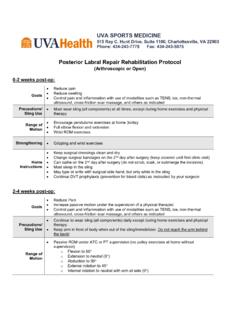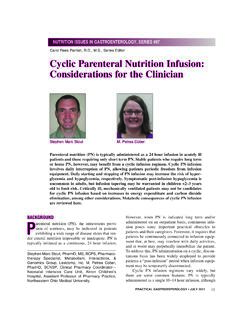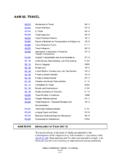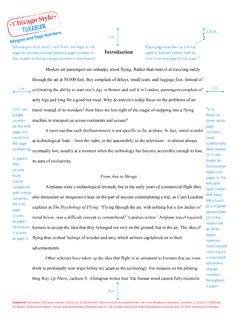Transcription of The Case of James Leininger An American Case of the ...
1 THECASE OFJAMESLEININGER:ANAMERICANCASE OF THEREINCARNATIONTYPEJim B. Tucker, MDAbstract:Numerous cases of young children who reportmemories of previous lives have been studied over the last50 years. Though such cases are more easily found in culturesthat have a general belief in reincarnation, they occur in theWest as well. This article describes the case of JamesLeininger, an American child who at age two began havingintense nightmares of a plane crash. He then described beingan American pilot who was killed when his plane was shotdown by the Japanese. He gave details that included the nameof an American aircraft carrier, thefirst and last name of afriend who was on the ship with him, and a location and otherspecifics about the fatal crash. His parents eventually discov-ered a close correspondence between James 'sstatementsandthe death of a World War II pilot named James of James 's statements that was made beforeHuston was identified includes a television interview with hisparents that never aired but which the author has been able words:reincarnation, memory(Explore 2016; 12:200-207&2016 Elsevier Inc.)
2 All rights reserved.)INTRODUCTIONC ases of young children who report memories of previous liveshave been systematically studied for the last 50 ,2 Though individual cases were investigated earlier, it wasStevenson3who began the work in earnest with a trip toIndia in 1961. He spent the bulk of the next 40 years studyingthe cases, which he referred to as cases of the reincarnation type(CORT).4 9In many of them, the details the children gavewere found to match the life of one particular deceasedindividual, whom Stevenson called the previous investigators followed Stevenson's lead, documentingsimilar cases that were studied independently10 All of theresearchers worked primarily in areas where cases were easiest tofind, cultures with a general belief in reincarnation, thoughStevenson did study European11and American12ones as most of the identified cases have occurred in placeswhere people believe in reincarnation, some have suggestedthat social and cultural issues are critical factors in producingthe is argued that the parents'beliefs andexpectations shape both their interpretations of theirchildren's statements and their later memories of what thechild knew about the previous personality before thatindividual was identified.
3 It is thought that after the child'sfamily meets the previous family and they exchangeinformation, the child is credited with more specificknowledge about the previous personality's life than he orshe actually factor challenging such an explanation in some of thecases is a record of at least some of the child's statements thatwas made before the previous personality was identified. Inthat situation, there can be no question of whether the childactually made the statements before the previous personalitywas identified. A limited number of cases include such arecord, 33 in Western case with documentation likethis is of particular Leininger is the son of Bruce and Andrea Leininger , aProtestant couple in Louisiana in the United States. Beginningat the age of two, he made statements and demonstratedbehaviors that suggested he remembered the life of anAmerican pilot killed during World War II, a young manwho has now been identified as one James M.
4 Huston, Jr. Thecase has garnered significant attention, as the Leiningers toldtheir story in several television interviews and eventually wrotea book about their also included a chapter onthe case in a recent report includes a morethorough review of the documentation of James 'sstatementsand behaviors that was made before the pilot Huston wasidentified, which is critical in assessing the evidence of a past-life connection that the case provides. Though the case has theweakness that James 's father was the one who worked toidentify the previous personality, the substantial documenta-tion that is available suggests a striking similarity betweenJames's statements and the details of the life and death of oneparticular PRESENTATIONS tatements and BehaviorsJames was born on April 10, 1998. As related by his parents,thefirst noticeable incident in the case occurred in February,e-mail: of Perceptual Studies, University of Virginia Health System,210 10th St NE, Ste 100, Charlottesville, VA 22902 case REPORT200&2016 Elsevier Inc.
5 All rights May/June 2016, Vol. 12, No. 3 ISSN 1550-8307/$ , when he was 22 months old. His father took him to theCavanaugh Flight Museum outside of Dallas, as they wereliving in Texas at the time. James was fascinated by the planesand in particular by the World War II exhibit. When they leftafter three hours, James had some toy planes, as well as avideo calledIt's a Kind of Magicabout the Blue Angels, theNavy'sflight exhibition team. James loved the video, and hewatched it repeatedly for weeks. The trip and the video started(or uncovered) his love for planes. This passion may have ledto some of the knowledge of planes andflying that Jamesoften surprised his parents by voicing. The video, however,was clearly not the source of James 's information aboutWorld War II, since the Blue Angels group was founded in1946 after the war and his father made a second trip to the museumlater that spring, on Memorial Day weekend. James was againexcited throughout his time there, though he grew quiet inthe hanger that housed the World War II aircraft.
6 He stoodstaring and pointing at the planes, as if in two months of thefirst trip , James developed a habitof saying airplane crash onfire, and slamming his toy planesnosefirst into the family's coffee table. He repeated thisbehavior over and over, producing dozens of scratches anddents on the table. James 's father traveled a lot, and when Jamesand his mother would see him off at the airport, James wouldoften say, Daddy, airplane crash onfire. This happenedrepeatedly, despite his father's this time, James began having nightmares. Hisbehavior during them seems to have involved only screams atfirst, but then included words as well: Airplane crash onfire!Little man can't get out. (In their book, James 's parents quotehim as saying, Airplane crash! Plane onfire! Little man can'tget out! but in an earlier writing and an earlier interview, theyused the shorter quote.) James would shout this over and overwhile thrashing about and kicking his legs up in the a few months of this, he had several conversationswith his parents about the dreams, usually as he was preparingto go to sleep.
7 He indicated that they were memories ofevents from the past. He said his plane had crashed onfireand that it had been shot by the Japanese. Two weeksafter those statements, James said his plane was aCorsair, which was afighter plane that was developed duringWorld War II, and he talked aboutflying a Corsairseveral August 27, 2000, when James was 28 months old, hetold his parents he hadflown his plane off a boat. When hisparents asked him the name of the boat, he said, Natoma. After that conversation, his father searched online for theword and eventually discovered a description of the USSN atoma Bay, an escort carrier stationed in the Pacific duringWorld War II. He printed out the information he found, andthe footer of the printout includes the date he did (Fig. 1). James 's parents asked him a number of times for the nameof the little man in his dreams. He always responded withonly me or James . A few weeks after James gave the wordNatoma, his parents asked him if he could remember anyoneelse who was with the little man.
8 James responded with thename Jack day when James was just over two and a half, his fatherwas looking through a book he was planning to give his ownfather for Christmas, one calledThe Battle for Iwo Jima father reports that James pointed to a picture showing anaerial view of the base of the island, where Mt. Suribachi, adormant volcano, sits, and said, That's where my plane wasshot down. His father said, What? and James responded, My airplane got shot down there, Daddy. A week after that, James 's father talked to a veteran fromNatoma Baywho remembered a pilot named Jack Larsen. Hesaid Larsenflew off one day and never returned, so no oneknew what happened to the ongoing nightmares, James 's parents eventuallycontacted Carol Bowman, who had written a book aboutchildren's past-life began a lengthycorrespondence. Following Bowman's advice, James 'smother started acknowledging to him that the events he wasdescribing had indeed happened to him before, while empha-sizing that they were in the past and he was now safe.
9 Thenightmares then grew less violent and less 's parents said that when he became old enough todraw, he drew hundreds of battle scenes involving planes(Fig. 2). He signed them James 3. When his parents askedhim about this, he said the 3 referred, not to his age, but tohis being the third James , and he continued to sign hispictures that way even after he turned 4. James may havethought of himself as the third James because James Huston,the pilot, was James , June of 2002, James 's parents were interviewed by ABCNews for a segment that was to be part of a program calledStrange Mysteries. The program never aired, but since I wasalso interviewed for it, ABC sent me a copy of the the time of the interview, Huston had not been 1lists the items that were included in the report, andtheir subsequent comparison to Huston's experiences. Theywere all correct, or at least partially correct, for the interview, James 's father corresponded withan ABC producer about the name Jack Larsen.
10 She had acontact at the Center for Naval History who found a John Though it was ultimately determined that this manwas not the Jack Larsen onNatoma Bay, the correspondencebetween James 's father and the producer is useful as doc-umentation that he was indeed searching at the time for aman with that name. Two months later, James 's father wrote aletter to the veteran who had told him that a Jack Larsen hadserved onNatoma Bay. In the letter, he mentions this John , again documenting this part of the month after that, James 's father attended hisfirstNatomaBayreunion. He learned that the Jack Larsen fromNatomaBayhad survived the war. Though he was not at the reunion,he was still alive and James 's father soon visited him. He alsolearned that only one pilot from the ship was lost during theBattle of Iwo Jima, a 21-year old from Pennsylvania namedJames M. Huston, the reunion, James 's father turned his focus to Huston,as documented by a posting he made on a website looking forinformation.
















